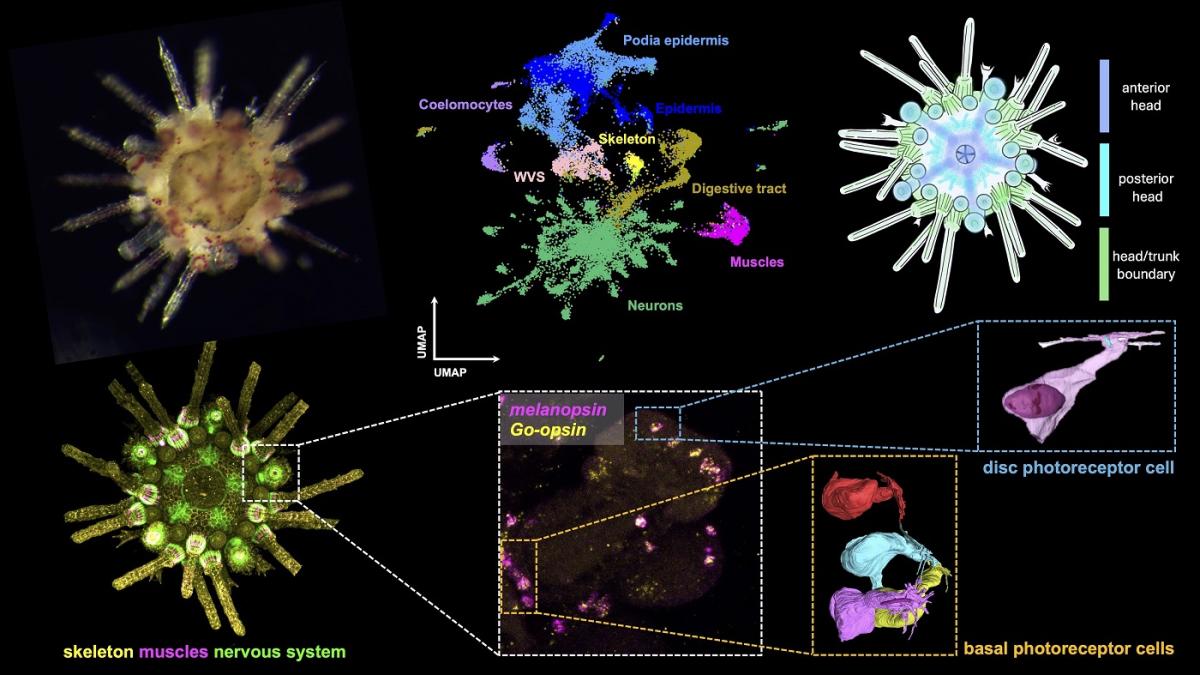New insights into the evolution of complex nervous systems
An international team of researchers, including scientists from the Museum für Naturkunde Berlin, has uncovered a surprisingly complex nervous system in sea urchins. The animals appear to possess an “all-body brain” whose genetic organization resembles that of the vertebrate brain. The team also identified light-sensitive cells distributed across the entire body—comparable to structures found in the human retina.
The study, funded by the Human Frontiers Science Program, was carried out in collaboration with the Stazione Zoologica Anton Dohrn in Naples (project lead), the Laboratoire de Biologie du Développement de Villefranche-sur-Mer, and the Institut de Génomique Fonctionnelle de Lyon. Its aim was to understand how a single genome can produce two radically different body plans: the bilaterally symmetrical larva and the adult animal with its fivefold radial symmetry—and to identify the cell types involved in this transformation.
A body made entirely of “head”
Using state-of-the-art single-cell and gene expression analyses, the researchers mapped the cell types of young post-metamorphic sea urchins. They found that the adult body plan is largely “head-like”: genes that in other animals define trunk structures are active only in internal organs such as the gut and the water vascular system. In sea urchins, a true trunk region is missing altogether.
An “all-body brain” rather than a simple nerve net
Most striking is the extraordinary diversity of neuronal cell types. Hundreds of different neurons express both echinoderm-specific “head” genes and highly conserved genes otherwise found in the vertebrate central nervous system. These findings suggest that sea urchins do not possess a simple decentralized nerve net, but rather an integrated, brain-like system that extends throughout the entire body.
“Our results show that animals without a conventional central nervous system can still develop a brain-like organization,” says Dr. Jack Ullrich-Lüter, one of the study’s first authors at the Museum für Naturkunde Berlin. “This fundamentally changes how we think about the evolution of complex nervous systems.”
Seeing without eyes
The team also discovered numerous light-sensitive cells (photoreceptors) expressing different opsins—proteins that respond to light. One particular cell type combines Melanopsin and Go-Opsin, suggesting a complex ability to detect and process light stimuli, and hinting at a previously underestimated visual capacity. In addition, large parts of the sea urchin nervous system appear to be light-sensitive and may even be regulated by light cues.
New perspectives on brain evolution
The findings challenge long-standing assumptions about the simplicity of echinoderm nervous systems and open up new perspectives on how complex neural and visual systems can evolve—even in animals without a centralized brain or true eyes.
Publication:
Paganos, P., Ullrich-Lüter, J., Almazán, A., Voronov, D., Carl, J., Zakrzewski, A.-C., Zemann, B., Rusciano, M.L., Sancerni, T., Schauer, S., Akar, O., Caccavale, F., Cocurullo, M., Benvenuto, G., Croce, J.C., Lüter, C., Arnone, M.I. (2025). Single Nucleus Profiling Highlights the All-Brain Echinoderm Nervous System. Science Advances. DOI: 10.1126/sciadv.adx7753


